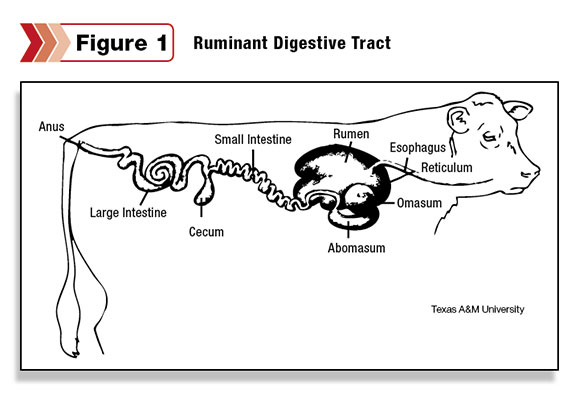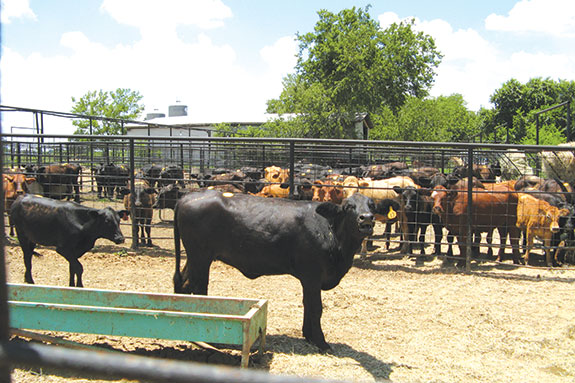Because of this fact, producers need to make every attempt to understand the ruminant digestive system and its processes.
During the 58th annual Texas A&M Beef Cattle Short Course, held in August of this year, Drs. Rick Machen and Ted McCollum discussed nutritional management.
The two Texas A&M AgriLife Extension Service beef cattle specialists suggested the following four areas where cattlemen should consider improving their understanding of ruminant nutrition:
- Ruminant digestive physiology
- Protein and energy digestion and use by ruminants
- Daily protein and energy required by a beef cow
- Tools available to producers to assist in decision making.
The first and second areas will be addressed in this article.
Ruminant digestive physiology
About two years ago, Dr. Joe Paschal, with Texas A&M AgriLife Extension, pulled a cow’s digestive tract from a big plastic bag in front of an audience at the Texas and Southwest Cattle Raisers Association (TSCRA) School for Successful Ranching.
Paschal laid the organs on a table in an orderly fashion and used them to explain how a cow digests her food starting with the esophagus. The following paragraphs are a recap of Pascal’s presentation.
It takes one to three days for food to pass through a cow’s digestive tract, depending upon what she eats.
A cow briefly chews food as she eats, breaking it into smaller particles. As she chews, digestive enzymes in her saliva are mixed with the food before it passes down the esophagus into the reticulum and rumen.

(Figure 1 shows the ruminant digestive tract in comparison to the monogastric digestive system).
Since digesta flows freely between the reticulum and rumen, these compartments are collectively referred to as the reticulo-rumen. The reticulo-rumen contains more than 50 percent of the total digestive tract capacity.
Most feed is fermented in the reticulo-rumen, but a small amount may pass unchanged into the omasum and abomasum.
Some of the larger food particles are regurgitated, chewed again and re-swallowed. We refer to the second chewing as “chewing the cud.”
Food is fermented and further broken down in the rumen by microbes. The stable environment in the rumen with a pH of 5.5 to 7.0 and a temperature range of 98.6 to 104 degrees F is conducive to microbial growth.
There are several different kinds of rumen bacteria and each one is very specific to the type of food they utilize and the end products they produce.
Rumen bacteria either digest cellulose, hemicellulose, starch, sugar, organic acids, protein or fat. In addition, there are bacteria that produce ammonia or methane or synthesize vitamins.
The specificity of rumen bacteria is the reason livestock specialists and animal nutritionists recommend that changes in feed be transitioned slowly.
Populations of bacteria that digest the new feed have to be established or the cow will have adverse reactions to the new diet.
Bacteria and other micro-organisms are ingested in feed or obtained from other animals. If the cow eats feed that her rumen bacteria utilize, the population will grow. As the population grows the cow can digest more of the food they eat.
If a cow doesn’t eat what her rumen bacteria utilize, the micro-organisms die. This is why cattlemen say that they feed “rumen bugs,” not the animal.
Protozoa, larger than bacteria, are found in the rumen and are classified according to their cell morphology. Species vary according to the type of diet, time of year and geological location.
Both bacteria and protozoa have food value to the cow. Dried microbes contain 40 to 50 percent crude protein and are over 75 percent digestible.
Digesta flows from reticulo-rumen into the omasum, which contains from 6 to 8 percent of the digestive tract capacity.
The omasum has many folds of tissue that resemble a partially open book. Water is reabsorbed from digesta and particle size is further reduced in the omasum.
Upon leaving the omasum, digesta passes into the abomasum, often referred to as the true stomach.
The abomasum secretes digestive enzymes that break feed down into protein, vitamins, simple carbohydrates, fats and amino acids for absorption into the small intestine.
Undigestible material passes into the large intestines where excess moisture is reabsorbed and fecal material is formed.

Protein and energy digestion and use by ruminants
“The key to ruminant nutrition is meeting the nitrogen (protein) and energy requirements of the microbes,” says Machen. “The cow’s protein requirements are often fulfilled when microbe protein needs are met.
“Protein is one of the main building blocks of the animal’s body. It is a major component of muscles, the nervous system and connective tissue.
Protein is composed of amino acid chains and is essential for maintenance, growth, lactation and reproduction.
“Microbes degrade plant proteins to various degrees in the rumen and use the resulting ammonia to synthesize microbial protein,” Machen continues. “Escape or non-degraded proteins are passed to the lower digestive tract along with microbial protein.
Digestive enzymes secreted in the abomasum break both plant and microbial protein into their component amino acids, which are absorbed from the small intestines into the bloodstream.”
Some high-quality proteins may be rapidly and almost completely degraded causing the created ammonia to enter the bloodstream without forming amino acids.
This action reduces essential amino acid availability to the animal. Extremely low-quality proteins may be upgraded during digestion to a higher-quality microbial protein.
“Protein, carbohydrates and fats provide energy in beef cattle diets,” says Dr. Jane Parish of Mississippi State University. “Energy is often referred to as digestible energy, net energy for maintenance (NEm), net energy for gain (NEg), net energy for lactation (NE) and, more often, total digestible nutrients (TDN).
“When digestible energy becomes limiting in beef cattle diets, intake and animal performance can suffer. Signs of energy deficiency include lowered appetite, weight loss, poor growth, depressed reproductive performance and reduced milk production.
Providing adequate digestible energy in beef cattle diets is important for animal health and productivity as well as ranch profitability.
“Carbohydrates are beef cattle’s main source of energy,” continues Parish. “They are either nonstructural (readily digested by all livestock) or structural (digested through fermentation that occurs in the rumen).
Ruminant animals, including beef cattle, have the unique ability to digest some structural carbohydrates in plant cell walls as a source of energy through microbial activity in the rumen.
Structural carbohydrates include cellulose, hemicelluloses and lignin. Beef cattle can digest cellulose and hemicellulose but cannot digest lignin.”
Animal nutrition can be very complicated to anyone not trained in the field, so most of us need to continue to study and learn from the experts. ![]()
PHOTOS
TOP: Hay can be a good source of energy or total digestible nutrients in cattle.
BOTTOM: Types of feed should be changed gradually to give new rumen bacteria time to develop. Photos courtesy of Texas A&M University.







